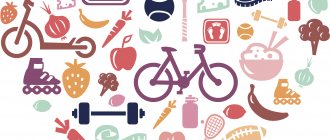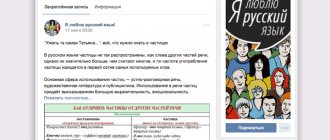Photos: Depositphotos / Illustration: Yulia Zamzhitskaya
“Scarlet Waltz. Flies from the ravine Copper farewells, grass finale. Gray clay, anxiety, ceremony, silence. The slate depths of leaf fall Fall into giant arcades..."
No, this is not a masterpiece of Silver Age poetry, but a mnemonic rule for remembering amino acids. The words in the poem begin with the same letter as the name of the amino acid: from alanine to histidine to arginine - yes, these are the names of amino acids. It becomes clear why memorization techniques were needed and that “slate” is not the worst word.
Every teacher has his own favorite mnemonic rules: they are learned from colleagues, invented together with students, and some are passed down from generation to generation for decades. Let's remember the techniques with which you can move away from cramming rules and concepts.
Rhyme
At school we were taught to memorize not long complex rules, but short rhythmic rhymes. This also works in adulthood. If you can’t rhyme the information you need, you can select lines and phrases rhythmically, and also combine them with the motive of your favorite song.
The technique is suitable if you need to remember a sequence of numbers that are not related to each other (for example, the number of a bank card or a friend’s car, a telephone number or a combination for an intercom).
Example:
We need to remember the phone number 151-46-63. The last number is three, so you need to find a rhyme for it, for example, “speak.” The result will be a rhyme like this:
“One, five, one, four, six, six, three. Do not tell anybody".
Memory training
Daily training is necessary not only for muscles, but also for memory. The more intensely you strain your brain, forcing it to work, the more your ability to analyze and remember information increases. Such exercises destroy mental routine and stimulate the emergence and development of new paths.
Basic requirements for exercises for brain and memory training:
- Complexity.
The task should provide new knowledge and cause mental effort. You can start learning a foreign language, learn to play a musical instrument, or learn how to solve Sudoku.
- Novelty.
If an activity is familiar and has already been practiced, then it will be of no use, even if it is difficult and intellectually exhausting. In order for memory and intelligence to develop, it is necessary to get out of the usual circle and occupy yourself with something new and unknown.
- Interest.
It is recommended to choose tasks that are exciting so that you don’t feel the urge to abandon them after a couple of days. The training should be challenging, but the desire to do it should not disappear any longer.
Use abbreviations
In life, we often use various letter abbreviations that we associate with the full name. The method, when only the first letter or part remains of each word, is suitable for memorizing long phrases, names, terms, the components of which are not logically connected.
Example:
We need to remember the list of products that we need to buy on the way home: apples, mayonnaise, oranges, tomatoes, bleach, arugula. To do this, you can group words into several abbreviations that are easy to remember. For example, it might look like this: MOUTH and PIT.
If the list is a little shorter, you can use parts of words rather than letters to form a memorable word. So, if you need to remember the words “pasta” and “lemon,” you can add the first syllables of the words and remember them as LIMA. Association with the capital of Peru will allow you to quickly remember what exactly you need to take in the store.
What is mnemonics?
Mnemonics or mnemonics
- These are specially developed techniques and methods that make it easier to memorize certain types of information. In some textbooks and courses, authors use the term “mnemonics” to denote the entire set of techniques and methods for memorizing information used for certain data, and the term “mnemonics” is interpreted as the practical application of methods defined for a given specific mnemonics.
The main principle of any mnemonics is the replacement of abstract objects with concepts that have a visual, auditory or, less often, other sensory representation, linking objects with existing information (building associations) to simplify its memorization.
Come up with associations
If you have well-developed imaginative thinking, this technique will be the most effective and interesting. It consists of coming up with an association between several words, objects or facts that, at first glance, have nothing in common with each other. Use your imagination, because the association can and should be unusual and even absurd - this way you will better remember the necessary information.
Here you can use images of relatives, singers, actors, artists, directors and all those who are firmly entrenched in our minds.
Example:
You just can’t remember the name of your new neighbor in the country. Outwardly, he reminds you of your cousin and has the same name. Come up with and remember the following association: “This neighbor is like a brother to me.” Next time, your brain itself will give you the name you need through association - it will be enough just to think about your brother when you meet your neighbor again.
Development of a system for mnemonic memorization of numbers
Quite a long time ago I set myself the goal of learning to memorize numbers, mainly just as a task for self-development; I did not find any obvious practical benefit. However, I want to remember phone numbers, transport routes, dates. It was difficult for me to find and start using a ready-made solution, but I wanted to work on my own.
- Prerequisites
- How to check if the system is good?
- Checking several systems
- How to create a better system
- Repository link and afterword
- Mnemonics are a method of remembering using chains of associations. The most convenient way to remember chains of words is by imagining each word as an image and linking them together. The brain remembers such graphic-spatial information more easily. For example, you can memorize key words from each abstract for a report. At the same time, it is important to choose the images correctly; they must be of the same order and not too abstract, otherwise their interaction will not be so colorful and will be difficult to remember.
- To remember numbers, numbers are encoded with letters - each number is associated with several vowels, usually from 1 to 3. Two- and three-digit numbers are encoded in one word of two and three syllables, respectively. Or, more precisely, two or three occurrences of vowels; there may be only one syllable. For example, if 1 is D, 2 is P, then 11 is grandfather, 12 is depot, and 22 is just a butt.
- Thus, to quickly memorize numbers, you need to know by heart which numbers correspond to which letters and come up with words and link them into chains.
- In practice, coming up with words each time is slow, so you need to learn 100 words for numbers from 0 to 99. Professionals sometimes know words up to numbers up to 999.
- At the same time, for some reason, the mnemonic systems that I found use such correspondences that it is difficult to come up with words, and not very easy to remember either. They use letters that sound or spell like numbers to make the correspondence easier to remember. Although it doesn’t get any easier, because... 1-2 numbers are not similar, but there are many options for “similarity”.
- I would like to separately note that I did not undertake to use the mnemonic system in English, because it seemed to me that my knowledge of the language was not enough; after all, I cannot think quickly in it.
- So the question arises, is it possible to choose more convenient matches? It was planned to use exhaustive search or machine learning methods for selection.
Since I consider the main disadvantage of the systems found to be the difficulty of composing words for some numbers, I would like to count the number of words.
Instead of using any book, I used a ready-made frequency dictionary. The dictionary is based on the national corpus of the Russian language, which, in turn, includes an analysis of many books and poems of different genres.
The frequency dictionary is available as a csv file, which I decided to analyze. Below are screenshots from the Jupyter Notebook; for those interested, there is a link to github at the end of the article.
As you can see, the data contains:
- the word itself (lemma)
- part of speech designation
- four frequency metrics described in the introduction to the dictionary
I chose one frequency metric because I only care about ranking. Through trial and error, it turned out that the nouns are “s”.
That leaves two columns and 22,050 words.
However, among these words there are many that I do not know. In addition, I don’t want “rare” letters to be the main ones in the code, so I decided to select words that do not have such rare letters. As it turned out later, the idea was not very workable, but still.
Having chosen “simple” and “complex” letters, let’s count their number. In addition, we will display the total number of consonants in the word.
Note:
- allchars corresponds to the number of digits that can be encrypted with this word
- chars is something that can be directly mapped to a number if you have the appropriate mapping (I'm on purpose)
- this code is the only one in this article that does not work “instantly”, but takes about 10 seconds; I didn't think about how to do it faster
Next, I thought that I needed to select words with 2-3 consonants, without “complex” letters, and also choose those that I know. You can cut off the list sorted by frequency at your discretion. As I later found out, this idea is also not very good, because... The distribution of words is uneven: after all, among the rare words there are many well-known ones.
Anyway, 2500 words were included in the “good” words, since I don’t know what tape and spud are. Of these, 707 words encoded numbers from 10 to 99 and 1,793 numbers from 100 to 999. It should be noted that 707 words are not that much for 90 numbers, less than 10 words per number, and this includes abstract and unknowns.
Next I set the following functions:
- getallcombos recursively counts all combinations that can be used to encode a number using mapping (dictionary number: letters) (ns - number as a string); returns a list of combinations
- testmaping checks how many words from words_for_test (DataFrame with our columns, including chars - only consonants) can encode numbers from 10 to 100 according to the provided mapping; returns a list with the number of words for each number
- testresult prints some statistics; Taking into account the experience in preparation, for the article I left only the line with “0-5 words”, which shows how many numbers were encoded with 0 words, how many with only 1 word, etc.
Thus, to check any mapping, it is enough to set it and call the testing function.
The first system I came across was Giordano. Many mobile applications for teaching mnemonics are based on it, and it is also mentioned on the Internet, see, for example, here.
She was the one who seemed difficult to work with. Try, for example, to come up with words for 84 or 11. I note that in the applications there are ready-made images for numbers, but then you need to remember exactly them, a hundred of them. In this case, there is another option to remember some of your own, close images.
Anyway, the test results are:
The results for all words are difficult to immediately interpret, but for “simple” words it is clear that for 22 numbers there is not a single word at all.
Another mapping, based on which letter the name of the number begins with, is given on one self-development site. Let's check:
As you can see, it has become much worse; there are no words at all for 8 digits. I note that, for example, there are few words where there are only two consonant letters R. But it is even more a bad idea to use only rare letters like Ш and Ш for the code.
In the process of selecting a better system, the following steps included:
- [0, 4, 7, 11, 15] Our baseline from the Giordano system
- Think about a brute force or machine learning algorithm. I didn't come up with this and decided it was better to adjust based on the frequency of occurrence of the letters.
- [4, 8, 11, 15, 19] First, I took all the popular letters and coded them. I did not use the letters ФЧШШЧ.
- [1, 1, 5, 5, 7] Added all letters. It has already become somewhat better, but there are still numbers that cannot be encoded, this is an unacceptable deterioration.
- [1, 2, 5, 9, 16] I had previously used the frequency of letters from the Internet, but then I decided to calculate it myself in the corpus, rearranged the letters, it didn’t get any better.
- [0, 0, 1, 3, 5] And then I realized the now obvious thing. Have you guessed it?
I realized that it is not the frequency of occurrence of letters in a word as a whole that is important, but the frequency of their occurrence in 1st and 2nd places in a word (for encoding two-digit numbers). It is necessary that for each number there are such letters that the probability of finding one of these letters at the beginning or at the end of the word is the same.
We count frequencies in 1st place, 2nd place and 2 places at once:
It then seemed easier to me to copy the output into a spreadsheet editor and select a cipher so that the frequencies were distributed as evenly as possible between the encoded digits.
Let's look at the result:
As you can see, for “simple” words there are still uncodable letters. For example, because no word contains PP, and the letter CH was not in “simple” words. In the end, I decided that it would be more correct to count by all letters.
Let's look at the words that were included in the final list for some numbers:
As you can see, the actual words fit somewhat less. We cannot use despondency, war, guilt, stench, wind, new, new, and also words that we do not know. However, there are still many good words for all numbers, including three-digit numbers.
The laptop code, data and article text are here: Github
I hope you liked it, and I will also be glad to receive advice:
- how do you remember numbers?
- how to make a complete search of valid mapping options?
- how to quickly master the method?
- Please write in private messages about typos and possible improvements in the design of the article.
Use Cicero's method
This method continues the technique of creating associations and is suitable when you need to remember a daily routine, a piece of text, a list of phone calls - any sequence.
The Roman orator Cicero, who is famous for his speeches, did not use notes when speaking to the public. He reproduced historical dates, names and quotes from memory. The following method helped him in this: the speaker mentally arranged the units that needed to be remembered in a well-known room in a certain order. During his speech, Cicero imagined the room and easily remembered the necessary names and dates.
The method is also called the place method or the Roman room method.
Example:
You need to remember the sequence of words: puppy, cheese, ruler, plasticine, puddle. Mentally, you imagine your room, in which you know every detail, and walk through it, sorting through the objects one by one:
“There is a puppy sitting in front of the room. I go inside and to the left of the door I see a chest of drawers with a cheese sandwich on it. I pass by the chest of drawers and see a desk, and on it there is a yellow ruler, it immediately catches my eye. I move on, approach the window and see a plasticine figure on the windowsill. Turning it over in my hands, I head to the exit of the room and pass by a sofa, the wooden legs of which are swollen from water, as it is standing in a puddle.”
Memorizing foreign languages
Language mnemonics will be useful for memorizing words, expressions, grammatical rules, verb forms, etc.
Method of phonetic associations (MPA). This method appeared due to the fact that in all languages of the world there are words or parts of words that sound the same, but have different meanings. Moreover, in different languages there are words that have a common origin. For example, the word look can be remembered by associating it with the similar-sounding Russian word “onion.” And when cutting an onion, we cannot “look” at it, because our eyes water.
Method of interaction of all sensations (MSI). This mnemonic approach is useful for those who want to become fluent in a foreign language. If words don't come to your mind automatically, you won't be able to speak the language fluently. Therefore, the main thing is not to memorize a foreign word as a translation of a native word, but to immediately associate the foreign word directly with the corresponding concept. To learn the word “cup,” imagine a cup with a handle, and holding the image in your mind, say “cup” several times, trying not to remember the word “cup.”
Try to put these methods into practice and take training on memorizing foreign words using mnemonics:
Statistics Full screen
Use the Aivazovsky method
Using this method, which is attributed to the famous marine painter, you can connect photographic memory. She will come to the rescue when you need to remember in the smallest detail any view, picture or image of a loved one.
Look at an object, landscape or person for three to five seconds, trying to remember the details. Then close your eyes and mentally imagine the object in the smallest detail. Ask yourself questions about the details of this image and mentally answer. Then open your eyes for one second, look at the object again and complete the image. Squint your eyes and try to achieve the brightest possible image of the object. Repeat the last two steps several times.
An association can be formed in three main ways.
Highlighting the basis of the association. One image in the association is chosen as central and is mentally imagined as larger; other association images are connected to different parts of this central image (memorization for different parts of the image). While maintaining the sequence of images in the association. The images included in the association are connected sequentially in pairs according to a certain system. For example, from left to right or from top to bottom, as we usually write. In this case, all images are grouped near the first image so that the entire association is visible entirely and simultaneously. Arbitrarily. All images of association are approximately equal to each other and are connected arbitrarily, without a specific system. The main thing when forming an associative connection is to mentally imagine all the images of the association at the same time.
Examples of forming an associative connection Imagine a candle. Pierce it with a pencil. Insert the needle into the pencil. Tie a string to the knitting needle. Tie a weight to a string. Place a butterfly on the weight. Make sure that all the images are arranged closely around the first image (candle). After creating paired relationships, try to see the entire association.
Practice visualization
The technique will allow you to remember numbers and names well. To do this, you need to figuratively, in detail, imagine the information being remembered.
Example:
You need to remember the name. Imagine each of its letters: they are covered with ivy, some have flowers growing on them, and so on. How many letters are there in total? Recalculate. Which one is the first? What is the second one like, what does it look like? As a result, you will be able to break information down into components and remember each one. And when the brain receives a request on this topic, it will simply put together the puzzle.
The main operation with associations is connecting images.
We imitate the natural process of perception followed by memorization and in our imagination we can combine several images. The brain then remembers the relationship between them. And then from one of these images he can recreate the entire picture. The operation “connecting images” is a kind of switch for the memorization mechanism.
In this case, it is necessary to form THREE SEPARATE CONNECTIONS. To do this, the necessary images are connected in the imagination and held together for about 3-6 seconds.
Development of memory using mnemonics
Memory training and exercises for brain development and memorization
Mnemonics are not suitable for memory development. The natural potential for memorization remains the same. But the use of mnemonic techniques will improve the efficiency of memorization. They are based on the most effective types of memory: visual and spatial. It is necessary to assign associations to elements of remembered information. For example, the word “happiness” has a happy emoji associated with it. By creating an association, a person automatically stores the necessary information in memory.
Important! Mnemonics involves a thoughtful approach to memorization. Mechanically creating associations will lead nowhere.
A professional approach to memorization is always systematic, based on several techniques combined with each other. You can learn one technique, but in practice it will be of little use, although the effectiveness of one mnemonic technique is much higher than mechanical memorization.
Memory training
Advantages of mnemonics:
- Simplicity. It is not difficult to master the memorization technique.
- Efficiency. Excellent for remembering precise information when simple perception is not enough to learn the material.
- Wide range of applications. It is well suited for preparing for exams, planning your day on the way to work, and for speaking at a conference. Mnemonic performances have become a classic, when people on stage can use it to remember a hundred words from one perception.
Disadvantages of mnemonics:
- Low memorization speed. Therefore, it cannot be used to remember information rich in facts. Unless you create a structure and learn it, then try to repeat it.
- Requires training. For the first time, mnemonics will be very tiring, and it is unlikely that you will be able to remember more than ten images. As you level up your skill it will become easier. Moreover, you need to train for a long time, it is advisable to devote at least several hours a day to this.
- Does not replace understanding. Mnemonics are closer to cramming than to real mastery of the material. Therefore, you still need to delve into it. If the information is complex, it can be memorized so that it can be analyzed in more detail later. This is an effective method, but blind memorization of facts is not enough to gain expertise in any matter.
In any case, mnemonics are a good tool for increasing the efficiency of your memory. Most of us are born smart and capable, it’s just that many have not learned to use their minds.
Memory development in children
Mnemonics is a skill for older people. It is difficult to teach a child how to create mind palaces, or to explain to him the principles of the alphanumeric code. A simple technique that children can also learn is an acronym (a phrase where the first letters of each word correspond to the first letter of the terms being memorized). A typical example is “every hunter wants to know where the pheasant is sitting.” This technique is good for memorizing a small number of words.
Rules for creating an acronym:
- Logic. Each word in an acronym must be logically related to the previous one. For example, you can write a short story.
- Imagery. Visual thinking is evolutionarily more ancient, so it is better developed, especially in a child. Therefore, the acronym must be descriptive.
- Language. It is not recommended to use phrases that contain words that are not related to the acronym. The sentence itself should be as close as possible to the spoken language.
- Clarity. You need to clearly know the subjects themselves before learning their sequence. Before you can use the word argon to create an acronym, you need to learn it.
- Unusuality. Mnemonics is a creative process. Unusual associations are remembered better.
Some give advice to develop mnemonic skills by the age of 3-4 years.
Another mnemonic technique is to prepare a card index, lay out the cards, and let the child make a story based on them. This method is not only a way to improve memory, but also allows you to form coherent speech.
Mnemonic rules
Phenomenal memory - what is it, methods for developing information memorization
The essence of mnemonics comes down to the creation and connection of visual images. There are a number of rules by which they are formed:
- Images must be large. If we imagine that the imagination is a screen, then the imagined image should occupy its entire area.
- The image must be detailed. If you imagine a tree, then you need to consider every part of it: crown, bark, roots, every leaf. The more details are presented, the more neurons are activated in the brain, and the more likely it is that the picture will be stored in the head.
- The image should be colorful, ideally multi-colored.
To strengthen the skills of creating images that comply with these rules, there are special applications. You can practice these skills on your own. All mnemonic memorization techniques in psychology are based on these rules.
Definition of mnemonic memory
Mnemonic memory is a skill that allows you to consciously remember the right things. It does not work without the inclusion of a person. If you do not use the skill of mnemonics, then a person will not be able to independently control what facts he retains in his head. The brain will do this automatically, and errors may occur.
Mnemonic memory
Another characteristic of mnemonic memory is the need to repeat learned material with a certain frequency. The fact is that 40% of the learned information is lost within an hour. After a week, almost nothing remains in my head. Therefore, it is necessary to repeat the material covered with ever-decreasing frequency.











